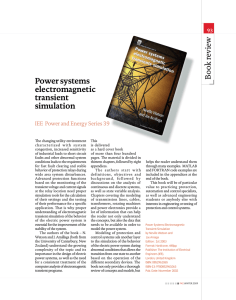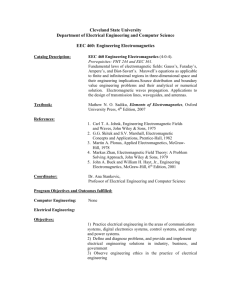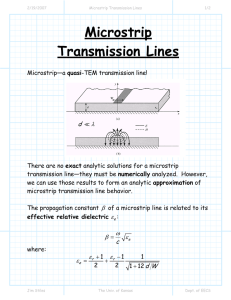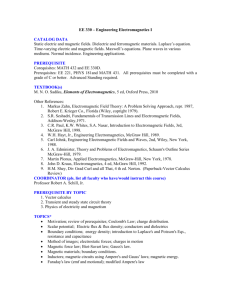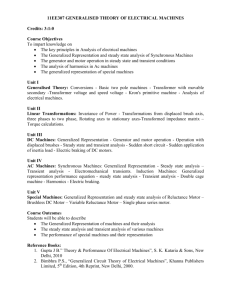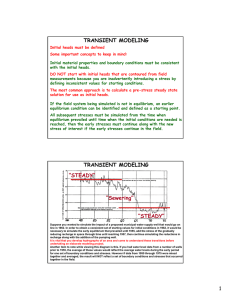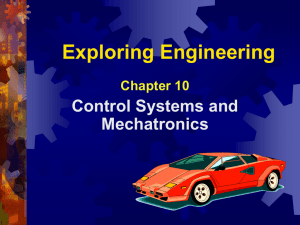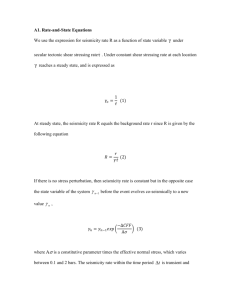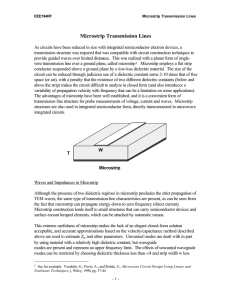EE430_ECG630 - Transmission Lines - Department of Electrical and
advertisement
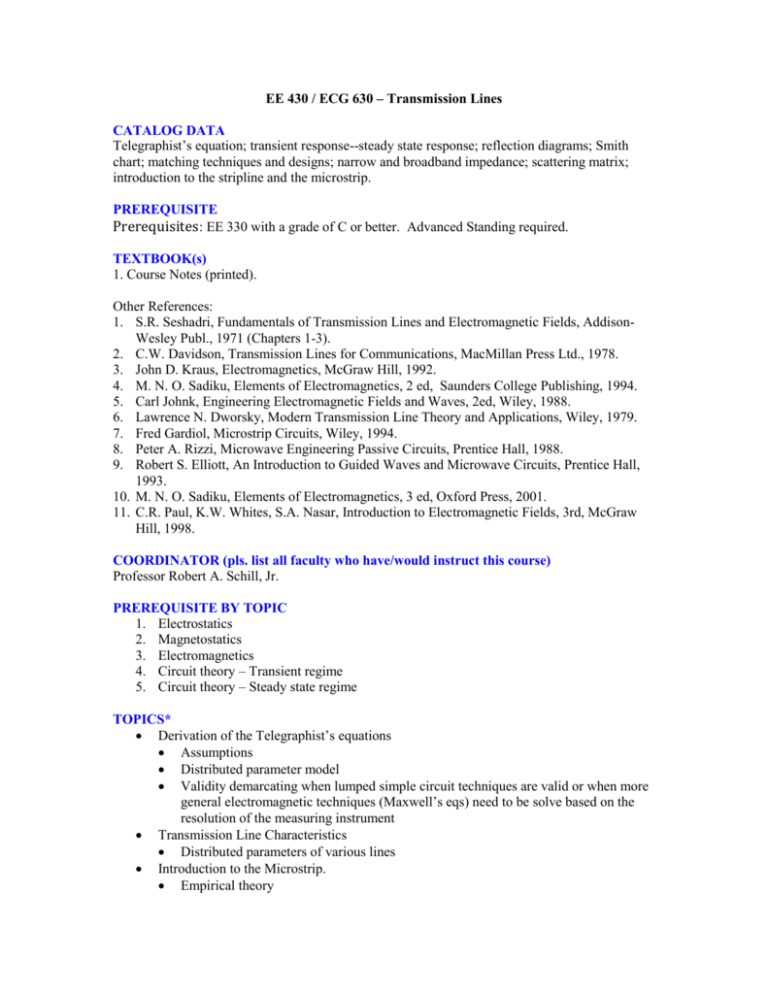
EE 430 / ECG 630 – Transmission Lines CATALOG DATA Telegraphist’s equation; transient response--steady state response; reflection diagrams; Smith chart; matching techniques and designs; narrow and broadband impedance; scattering matrix; introduction to the stripline and the microstrip. PREREQUISITE Prerequisites: EE 330 with a grade of C or better. Advanced Standing required. TEXTBOOK(s) 1. Course Notes (printed). Other References: 1. S.R. Seshadri, Fundamentals of Transmission Lines and Electromagnetic Fields, AddisonWesley Publ., 1971 (Chapters 1-3). 2. C.W. Davidson, Transmission Lines for Communications, MacMillan Press Ltd., 1978. 3. John D. Kraus, Electromagnetics, McGraw Hill, 1992. 4. M. N. O. Sadiku, Elements of Electromagnetics, 2 ed, Saunders College Publishing, 1994. 5. Carl Johnk, Engineering Electromagnetic Fields and Waves, 2ed, Wiley, 1988. 6. Lawrence N. Dworsky, Modern Transmission Line Theory and Applications, Wiley, 1979. 7. Fred Gardiol, Microstrip Circuits, Wiley, 1994. 8. Peter A. Rizzi, Microwave Engineering Passive Circuits, Prentice Hall, 1988. 9. Robert S. Elliott, An Introduction to Guided Waves and Microwave Circuits, Prentice Hall, 1993. 10. M. N. O. Sadiku, Elements of Electromagnetics, 3 ed, Oxford Press, 2001. 11. C.R. Paul, K.W. Whites, S.A. Nasar, Introduction to Electromagnetic Fields, 3rd, McGraw Hill, 1998. COORDINATOR (pls. list all faculty who have/would instruct this course) Professor Robert A. Schill, Jr. PREREQUISITE BY TOPIC 1. Electrostatics 2. Magnetostatics 3. Electromagnetics 4. Circuit theory – Transient regime 5. Circuit theory – Steady state regime TOPICS* Derivation of the Telegraphist’s equations Assumptions Distributed parameter model Validity demarcating when lumped simple circuit techniques are valid or when more general electromagnetic techniques (Maxwell’s eqs) need to be solve based on the resolution of the measuring instrument Transmission Line Characteristics Distributed parameters of various lines Introduction to the Microstrip. Empirical theory Engineering differences between the microstrip and the stripline; advantages and disadvantages Time allowing the scattering matrix with application to the Vector Network Analyzer. Various transmission line approximations in time domain Low loss line Diffusion line Dispersionless line Time domain transient response theory (Lossless lines) Steady state limit to a DC source Propagation of pulses and general transient waveforms launched on a line Line response to switiching Cascaded lines with interconnecting or terminating by linear and nonlinear loads Bounce diagrams Temporal and spatial voltage and current distribution plots Introduced to the time domain reflectometer. Inverse problem Laplace transform technique of transient response on a transmission line. Steady state response (Lines with and without loss) Propagation of time harmonic signals on a line terminated by linear loads Line characteristics: characteristic impedance, propagation coefficient, Standing Wave Ratio, wave impedance, reflection coefficient Slotted line measurements with applications to unknown load Crank diagram and Smith Chart development and application. Narrow band matching devices Quarter wave transformer Single stub tuner Double stub tuner Introduction to select topics in wide band matching devices (e.g., multiple quarter wave transformers, tapered line, Butterworth transformer, Tchebyscheff transformer) COURSE OUTCOMES (ABET course outcomes) [UULO course outcomes] Upon completion of the course, students will be able to: 1. Define the realm of validity of transmission line theory and how it fits in with existing theories the student is exposed to. (1.3, 1.6, 1.8) 2. Examine both the transient and steady state response of transmission lines terminated by a variety of different types of loads.(1.1, 1.2, 1.3, 1.4, 1.6, 1.7, 1.9) [2] 3. Study and use of bounce diagram and Smith chart tools for transmission line problems with passive loads. (1.6, 1.10) 4. The student will be able to solve transmission line problems both graphically and analytically. (1.1, 1.2, 1.10) [2] 5. The student will learn the concept of matching and employ various narrow band and possibly wide band matching techniques. (1.6, 1.7, 1.8, 1.9) [2] 6. The student will be introduced to the scattering matrix and apply it to various devices. (1.10) 7. The student will be exposed to various microstrip and/or stripline technologies. (1.6, 1.7, 1.8, 1.9, 1.10, 1.11) [1,2] 8. The student will gain some hands-on experience in designing and measuring the properties of transmission lines. (1.3, 1.4, 1.6, 1.7, 1.8, 1.10, 1.11, 3.3) [1,2,3] COMPUTER USAGE Limited usage of Matlab and PSpice. GRADING Homework assigned weekly; One midterm on transient respond; One final exam on steady state response; one or more hands-on design projects. ABET COURSE OUTCOMES 1. The appropriate technical knowledge and skills 1.1. An ability to apply mathematics through differential and integral calculus, 1.2. An ability to apply advanced mathematics such as differential equations, linear algebra, complex variables and discrete mathematics, 1.3. An ability to apply knowledge of basic sciences, 1.4. An ability to apply knowledge of computer science 1.5. An ability to apply knowledge of probability and statistics, 1.6. An ability to apply knowledge of engineering 1.7. An ability to design a system, component, or process to meet desired needs within realistic constraints 1.8. An ability to identify, formulate, and solve engineering problems 1.9. An ability to analyze and design complex electrical and electronic devices 1.10. An ability to use the techniques, skills, and modern engineering tools necessary for engineering practice. 1.11. An ability to design and conduct experiments, as well as to analyze and interpret data 2. The appropriate interpersonal skills 2.1. An ability to communicate effectively 2.2. An ability to function on multidisciplinary teams 3. The knowledge and skills to be responsible citizens 3.1. An understanding of professional and ethical responsibility 3.2. The broad education necessary to understand the impact of engineering solutions in a global, economic, environmental, and societal context 3.3. A recognition of the need for, and an ability to engage in life-long learning 3.4. A knowledge of contemporary issues 3.5. A knowledge of the basic content and concepts of the U.S. and Nevada constitutions UULO COURSE OUTCOMES 1. Intellectual Breadth and Lifelong Learning 2. Inquiry and Critical Thinking 3. Communication 4. Global/Multicultural Knowledge and Awareness 5. Citizenship and Ethics COURSE PREPARER AND DATE OF PREPARATION Robert A. Schill, Jr., Last update date December 9, 2014
